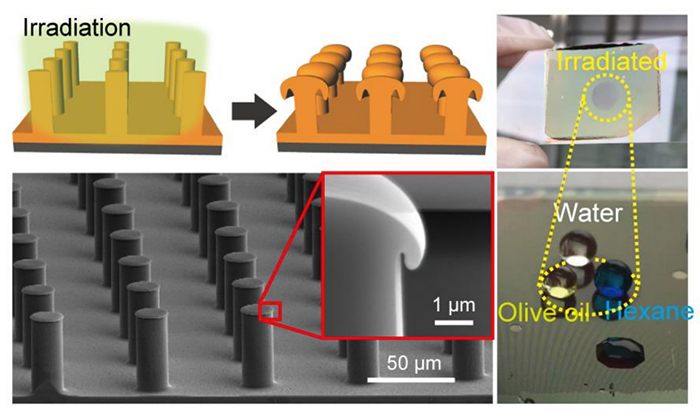Superomniphobic surfaces, which remain liquid-free for both water and oil, are potentially useful in diverse applications, including stain-free fabrics, non-biofouling medical tubing, and applications that require corrosion-free surfaces. A KAIST research group led by Professor Hee- Tak Kim and Professor Shin-Hyun Kim of the Department of Chemical and Biomolecular Engineering has developed a fabrication technology that produces such a superomniphobic surface over a large area and at low cost through the photofluidization of an azobenzene molecule-containing polymer. The results of this study were published in the August issue of ‘ACS Nano’, an American Chemical Society journal.
Mushroom-shaped surface textures, also called doubly re-entrant structures, are known as the most effective type of surface structure to enhance resistance against liquid invasion, exhibiting superior superomniphobicity. However, because the doubly-reentrant structures are sophisticated, the fabrication procedures have been limited to conventional lithography thechniques, such as silicon micro-machining, which is very delicate, time-consuming, and expensive. More importantly, the material that can be used in such fabrication procedures is restricted to an inflexible silicon wafer, which severely limits practical applications.
To overcome these limitations, the research team utilized the peculiar optical phenomena of an azobenzene molecule-containing polymer (referred to as azopolymer) called localized photofluidization; the azopolymer becomes fluidized under irradiation, and fluidization takes place locally within the thin surface layer of the azopolymer. The research team conducted localized photofluidization in the top surface layer of azopolymer cylindrical posts, which successfully reconfigured the cylindrical posts to a doubly re-entrant geometry as the fluidized thin top surface of the azopolymer flowed down.
The photofluidization-induced doubly-reentrant structure exhibits a superior superomniphobic property even for liquids with an almost zero equilibrium contact angle. In addition, the research team demonstrated that polymeric omniphobic films can be formed on flexible substrates, and the superomniphobic property can be maintained on curved target surfaces. Moreover, the fabrication procedure, which consists of soft-molding and photofluidization, is highly reproducible and scalable, providing a practical route to creating robust omniphobic surfaces.
Professor Hee-Tak Kim said, “The novel photo-fluidization technology in this study not only produces superior superomniphobic surface but also possesses many practical advantages in terms of fab-procedures and material flexibility; therefore, it would greatly contribute to real- usage in diverse applications.”
Professor Shin-Hyun Kim said, “The designed doubly re-entrant geometry in this study was inspired by the skin structure of springtails, insects that dwell in soil and breathe through their skin.”, and added, “Humans can learn from nature and create new engineering designs.”

Kim, Heetak (Dept. of Chemical and Biomolecular Engineering)
Homepage: http://eed.kaist.ac.kr
E-mail: jaehodanny@kaist.ac.kr






